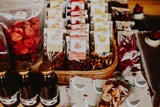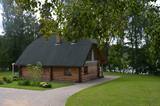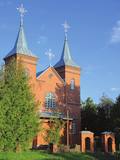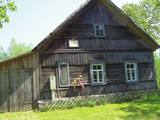| Nr | Name | Beschreibung |
|---|---|---|
|
The farmwoman grows vegetables and fruits to produce tasty preserves, syrups, jams, chutneys and dried fruit. You can taste and purchase the products, go on a tour of an escargot farm, and taste escargots cooked in the Burgundy style. Children’s camps can be organised. |
||
|
The most important aspects of this park are a shallow lagoon-type lake – Lake Pape, with its flood land meadows, the shore of the Baltic Sea, the Nida swamp, and the more than 270 different types of birds that have been spotted here. The oldest bird ringing station in Latvia (est. 1966) is found between Lake Pape and the Baltic Sea. Birds and bats are caught and ringed there. Lake Pape is the first place in Latvia where so-called “wild” horses (the “Konik” breed) were released with the aim of managing the flood land meadows.
|
||
|
Wenn man auf der Straße Nereta – Ilūkste fährt, kann man das Gotteshaus schon von weitem sehen. Es ist im Jahr 1805 gebaut, aber im Jahr 1888 restauriert worden. In der Kirche haben sich der ursprüngliche Altar, die Kanzel und der Orgelprospekt erhalten. An der Kirche sind die im Ersten Weltkrieg gefallenen deutschen Soldaten bestattet worden. An der westlichen Gebäudewand befinden sich zwei Gedenktafeln, die zu Ehren der im Ersten Weltkrieg gefallenen Einwohner der Gemeinde Laši und der während der Sowjetzeit Repressierten enthüllt sind. |
||
|
The holiday houses are located near Lake Ieva, 30 m from the lake shore. On the 1st floor of the holiday house - lounge with fireplace and glazed veranda, sauna (50.00 EUR / evening), small kitchenette, toilet. Outside-small terrace overlooking the lake. On the 2nd floor there are 2 isolated rooms and 10 beds. By the lake - a fireplace, a well-groomed swimming area with a footbridge. Boats and catamarans can be rented. |
||
|
The Slocene River flows through Lake Valgums and Lake Mazezers before flowing into the western part of Lake Kaņieris. It is part of a branched and swampy delta in which there are seasonal restrictions aimed at protecting birds. The wetlands which are alongside the river are difficult to access in many places. Before the Starpiņupīte was dug between Lake Kaņieris and the Bay of Rīga (the water level is regulated with sluices), the water from the river flowed along what is now the Vecslocene River all the way to Sloka, where it ended at the Lielupe River. The Vecslocene can be used by canoe boats only when the water level is high and then from the Old Ķemeri road to the place where the river enters the Lielupe. Between Milzkalne and Lake Valgums, the river is not navigable because of many fallen trees. During the springtime, the estuary of the Starpiņupīte is a good place for bird watching. |
||
|
15.janvāra naktī Kalpaka bataljons izcīnīja pirmo kauju pie Lielauces, atvairot sarkano uzbrukumu. Tā bija pirmā nozīmīgā Kalpaka bataljona kauja, kad uzvara karavīriem deva īpaši spēcīgu morālu stimulu. 1934. gada 19. augustā pie Lielauces luterāņu baznīcas atklāja pelēkā granītā veidoto pieminekli Oskara Kalpaka bataljona pirmās kaujas vietā. Piemiņas zīme veidota pēc arhitekta P. Dreimaņa meta. Lielauces kauja notika 1919. gada naktī no 15. uz 16. janvāri starp kalpakiešu Cēsu un Virsnieku rotu no vienas puses un 2. strēlnieku pulka karavīriem. 50. gadu sākumā piemineklis tika iznīcināts, bet atjaunots 1991. gadā |
||
|
Das Restaurant befindet sich in den Räumen des Hotels Hotel Jelgava. Hier werden traditionelle lettische, sowie auch andere Speisen angeboten und Musikabende organisiert. Lettische Küche: Straußensteak von Vögeln, die in Lettland gezüchtet sind. Das besondere Gericht: Maishähnchen mit Spinat-Kartoffel-Püree und Karotten, die am Spieß gegrillt sind. |
||
|
The Narūta River which flows out of Lake Ežezers is approximately 1 km long and ends at the small Obiteļi windmill lake. On the right bank of the river is a windmill that was built around 1900. Today the site has the Obiteļa leisure centre with a sauna and banquet facilities. |
||
|
Holy Trinity Roman Catholic Church of Stoļerova. The construction
works of the church were finished in 1999 by the support of dean Butāns. The building is slightly larger than
the previous one; the newest (restored) church in Rēzekne district. The church has a specific icon of Our
Lady that was transferred from the chapel of Rozenmuiža.
|
||
|
Ein neues Cafe, das sich auf dem Gelände des Naturparks „Daugavas loki” in Naujene befindet. |
||
|
Dieses Schutzgebiet befindet sich an der Ostküste des Ķīšezers – Sees. Hier sind die Habitats von größter Bedeutung – Auen und andere Wiesen, Dünen, das Aquatorium des Ķīšezers – Sees, die Küste, Eichenwälder, Schwarzerlen und andere Bäume und viele riesige Eichenbäume kann man im Schutzgebiet und jenseits seiner Grenze finden. Der Burgberg von Bulduri, der der wichtigste alte Burgberg im Rigaer Gebiet ist, befindet sich am südlichen Ende der Lieupsala – Insel. An der Grenze des Schutzgebietes befindet sich eine Zweigstelle des Lettischen Ethnographischen Freilichtmuseums, die unter “Vārnas” bekannt ist.
|
||
|
The House-Museum of the writer Michael Narics. Reveal the history of political repressions in the
USSR and Soviet Latvia; see creative works of the winners of competition organized by M. Narics Educational
Center.
Working hours: on request |
||
|
SIA “Rundāles Dzirnavas” 2021. gadā īstenoja projektu, lai izveidotu nelielu alus darītavu un uzsāktu alus ražošanu Rundāles ūdensdzirnavu teritorijā. Tiek ražots gaišais un tumšais alu, kura visas sastāvdaļas tiek iepirktas Latvijā, bet graudi no vietējiem zemniekiem. Videi draudzīgā iekārta atbilst jaunākajiem ES standartiem un prasībām. Latvijas un ārvalstu tūristiem ir iespēja apvienot Rundāles pils apskati ar vēsturisko dzirnavu muzeja un alus darītavas apmeklējumu. Kompleksa teritorijā ir daudz iespēju daudzveidīgai interesantai laika pavadīšanai. Vienas dienas laikā var apmeklēt aizraujošas ekskursijas pa dzirnavām un alus darītavu, pastaigāties pa vietējiem, tuvējiem apskates objektiem, uzņemt lieliskas fotogrāfijas, atpūsties pludmalē un vizināties ar laivu, katamarānu, SUP dēli. |
||
|
Saimniecība "Baltiņi" atrodas Auces novadā un nodarbojas ar lopkopību un lauksaimniecību. Viesiem ir iespēja redzēt un izzināt piena ražošanas procesu, kā arī iepazīt saimniecības dzīvniekus. Saimnieki piedāvā apskatīt padomju laiku auto kolekciju, pieejama arī suvenīru un trauku kolekcija ar govs motīviem. |
||
|
6 km südwestlich von Iecava befindet sich das Elternhaus von Eduards Virza (mit richtigen Namen: Jēkabs Eduards Liekna) (1883-1940), in das der Schriftsteller zusammen mit seiner Frau Elza Stērste 1901 zurückkehrte. Virza war einer der berühmtesten lettischen Dichter und Schriftsteller des 20. Jh., Publizist und Übersetzer von Poesie. Im Haus „Billītes“ entstanden viele Gedichte, und 1933 auch das legendäre Werk „Straumēni“, in dem das Leben des lettischen Bauern geschildert wird. Jetzt befindet sich im Haus „Billītes“ ein Virza-Museum. Dessen Begründer sind die Tochter des Schriftstellers Amarilis Liekna, deren Sohn Edvards Liekna, Tochter Anna Žīgure und Enkelin Diāna. Nach vorheriger Anmeldung können Besucher sich mit den Museumsexponaten und dem Werk von Virza bekanntmachen. |
||
|
This potter upholds pottery traditions from the village of Silajāņi. He produces glazed and unglazed products such as dishware, candelabras, etc. You will hear attractive stories about pottery, be allowed to knead some clay and work on the potter’s wheel, and be able to tour an exhibition hall with samples of the master’s work, as produced over the course of the years. You can also commission and purchase products. |
||
|
Das Wirtshaus befindet sich im Zentrum von Salacgriva: auf dem Platz des Bootsmanns, am Fluss Salaca. Das früher sehr bekannte Wirtshaus Pie Bocmaņa hat eine neue Innenausstattung über das Thema Münchhausen erhalten. Lettische Küche: Heringssalat, Hering mit Quark, Fischsuppe, Schweinebrust mit Zwiebeln, graue Erbsen mit Speck, gebratene Leber, gebratene Flunder, gebratenes Zanderfilet, geschichtetes Roggenbrot-Dessert. |
||
|
Die Gäste erwartet ein gesundes, für die Gegend charakteristisches Öko-Essen. Hier kann man das nationale Kulturerbe, verschiedene Legenden kennen lernen sowie Leckereien und Souvenirs kaufen. |
||
|
Atrodas iepretim bākai. Saukta arī par Pizes (Miķeļtorņa lībiskais nosaukums) baznīcu. To uzcēla 1893. g. Padomju laikā ēkā bija izvietots pionieru nometnes klubs. Tagad tā atkal kalpo savam pamatmērķim. |
||
|
Atrodas 200 m ziemeļaustrumos no akmens tilta pār Tebru. Ūdensdzirnavu komplekss celts 18. gs. beigās – 19. gs. sākumā uz Tebras upītes, uzpludinot Dzirnavdīķi. Blakus dzirnavām atrodas 19. gs. beigās celtā Aizputes muižas alusdarītava, apvienojot divas vecākas Pilsmuižas saimniecības ēkas. |
||





















